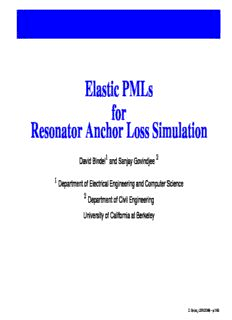
Elastic PMLs for Resonator Anchor Loss Simulation PDF
Preview Elastic PMLs for Resonator Anchor Loss Simulation
Elastic PMLs for Resonator Anchor Loss Simulation 1 2 David Bindel and Sanjay Govindjee 1 Department of Electrical Engineering and Computer Science 2 Department of Civil Engineering University of California at Berkeley D.Bindel,USNCCM8–p.1/45 Contributors Tsuyoshi Koyama – PhD Student, Civil Engineering Wei He – PhD Student, Civil Engineering Emmanuel Quévy – Postdoc, Electrical Engineering Roger Howe – Professor, Electrical Engineering James Demmel – Professor, Computer Science D.Bindel,USNCCM8–p.2/45 Outline Electromechanical resonators and RF MEMS Damping and quality of resonance Anchor losses and Perfectly Matched Layers Analysis of the discretized PMLs Complex symmetry and structured model reduction Analysis of a disk resonator Conclusions D.Bindel,USNCCM8–p.3/45 Outline Electromechanical resonators and RF MEMS Damping and quality of resonance Anchor losses and Perfectly Matched Layers Analysis of the discretized PMLs Complex symmetry and structured model reduction Analysis of a disk resonator Conclusions D.Bindel,USNCCM8–p.4/45 How many MEMS? D.Bindel,USNCCM8–p.5/45 Why resonant MEMS? Microguitars from Cornell University (1997 and 2003) Sensing elements (inertial, chemical) Frequency references Filter elements Neural networks Really high-pitch guitars D.Bindel,USNCCM8–p.6/45 Micromechanical filters Mechanical filter Radio signal Filtered signal Capacitive drive Capacitive sense Mechanical high-frequency (high MHz-GHz) filter Your cell phone is mechanical! Advantage over quartz surface acoustic wave filters Integrated into chip Low power Success =⇒ “Calling Dick Tracy!” D.Bindel,USNCCM8–p.7/45 Designing transfer functions Time domain: 00 0 Mu + Cu + Ku = bφ(t) T y(t) = p u Frequency domain: 2 ˆ −ω Muˆ + iωCuˆ + Kuˆ = bφ(ω) T yˆ(ω) = p u Transfer function: T 2 −1 H(ω) = p (−ω M + iωC + K) b ˆ yˆ(ω) = H(ω)φ(ω) D.Bindel,USNCCM8–p.8/45 Damping and filters 20 log |H(ω)| 10 ω Want “sharp” poles for narrowband filters =⇒ Want to minimize damping Electronic filters have too much Understanding of damping in MEMS is lacking D.Bindel,USNCCM8–p.9/45 Damping and Q Designers want high quality of resonance (Q) Dimensionless damping in a one-dof system: 2 d u du −1 + Q + u = F (t) dt2 dt C For a resonant mode with frequency ω ∈ : |ω| Stored energy Q := = 2 Im(ω) Energy loss per radian D.Bindel,USNCCM8–p.10/45
Description: